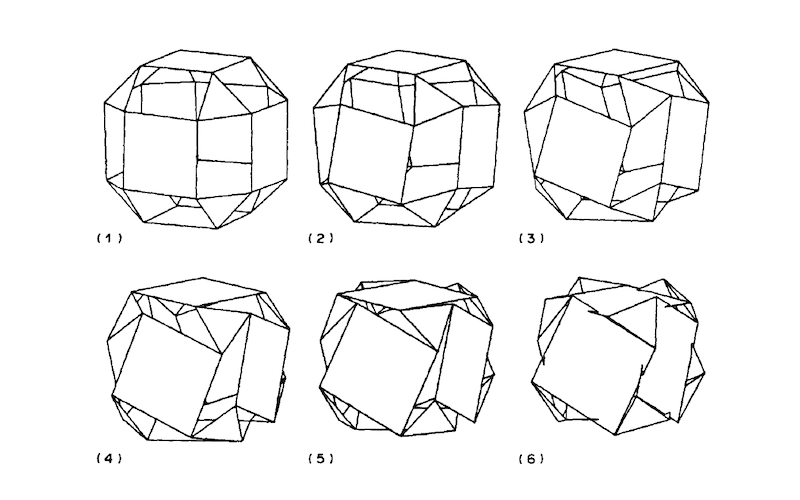
The concept of tensegrity emerged from the observation that finite systems maintain integrity through balanced tensional relationships of contiguous parts. These tensional relationships are achieved through the mechanical distribution of tension and compression.
The genesis of this concept is jointly ascribed to the sculptor Kenneth Snelson and Buckminster Fuller – the American neo-futuristic architect, systems theorist, author, designer, and inventor. Snelson’s sculptures and physical realisations of ‘continuous tension – discontinuous compression’ were popularised by Buckminster Fuller who had already been immersed in high frequency icosahedrons, energetic and universal geometries.


Buckminster Fuller, noted for his playfulness with language and meaning is credited with contriving the term tensegrity. Tensegrity is a contraction of two words: tension and integrity. The design principles of tensegrity have been employed to create an array of striking sculptural and architectural structures.


Biotensegrity refers to these tensional relationships in biological systems. Biotensegrity is evident across all scales – from molecules to whole organisms. Biotensegrity is materially and energetically efficient and through evolution has become a dominant organisational motif.



Biotensegrity is characterised by connected, dynamic, self-similar and nested polyhedral hierarchies. These characteristics balance the opposing functional demands of stability and movement. Biotensegrity enables interconnected close packing of cellular and extracellular materials. This level of interconnection creates integration within whole organisms across all scales, and also eliminates bulky and materially inefficient structures.
High frequency polyhedra (with many facets) also have a knack of performing so called Jitterbug transformations. Jitterbug transformations are energetic and structural shifts that are propagated throughout polyhedral networks, enabling material to expand and contract – this underpins the motion and movement of the organism.

In biotensegrity each component is made of smaller components that are composed of smaller components, each of these is made of still smaller components – this repeats in a fractal like manner right down to molecular levels. These components are ultimately reducible to polyhedra which are composed of straight lines (vectors) – however in biological tissues, high frequency polyhedra produce curves, spirals, helices.


WARNING:
THE READ MORE SECTION BELOW CONTAINS ANATOMICAL PHOTOGRAPHS OF DISSECTED HUMAN TISSUE
read more >

Biotensegrity can be observed in all biological tissues and processes, of varying scales, including the extracellular matrix-cytoskeleton, molecular self assembly, continuity and orientation of fascia, the complex function of many anatomical structures including the shoulder, knee, pelvis/sacroiliac joints, cranial sutures and dura have all been envisioned through the lens of biotensegrity.


It has been noted in nested biological hierarchies that no clear separation exists between skin, fascia, muscles, blood vessels and periosteum. All of these elements are folded within collagen networks – awash with lubricating molecules which create dynamic and fluid continuity – a sea of tension interspersed with isolated compression elements.
This arrangement has prompted some to speculate that the organism is a hyperbolic tensegrity – a material system which interpenetrates itself. This architecture originates in embryogenesis and is epitomised by the so-called Klein bottle – the disposition of fascia in the human embryo bears a striking resemblance to the Klein bottle.



Pre-tension is integral to biotensegrity. Pre-tension enables instantaneous material adaptation, to mechanical forces, without the need for neural integration, cortical processing and conscious level regulation.
Biotensegrity enables material and spatial self-organisation – which can be thought of as tensional homeostasis – the subconscious optimisation of our tissues in relation to gravity, motion and movement. We are perpetually shape shifting – always engaged in Jitterbug transformations!
FEATURED IMAGE:
H.F Verheyen. The complete set of Jitterbug transformers and the analysis of their motion (1989).
